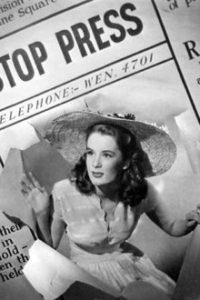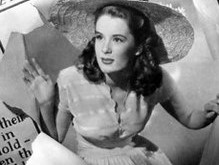Stop Press Girl ** (1949, Sally Ann Howes, Gordon Jackson, Basil Radford, Naunton Wayne, James Robertson Justice) – Classic Movie Review 10,883
Director Michael Barry’s 1949 black and white British B-film Stop Press Girl is a slack would-be fantasy about an attractive psychic young woman called Jennifer Peters (Sally Ann Howes) who can stop all kinds of machinery and mechanical devices with her mind. All the women in her family can stop anything they travel in. Jennifer stops her boyfriend’s car, and then a train she is travelling in, without being aware of it.
Jennifer leaves hicksville for the big smoke of London, and all her troubles – and those of her watchmaker boyfriend – start. There are big troubles when Jennifer takes over her sick friend’s job as an air hostess on a Handley Page Halton aircraft.
It could have been a thriller, or it could have been a drama, but it opts for a whimsical comedy and soon grinds to an unceremonious demise, its single joke premise unable to see it through 78 minutes.
However, the young Howes (just 18) is very sweet and nice, and, when the slapstick, farcical script gets too annoying, there is always some compensation in the gently attractive comic turns from the always personable Gordon Jackson, Basil Radford, Naunton Wayne and James Robertson Justice. It is another case of charming actors bailing out a feeble script.
An example of the comedy is that it is the kind of film where a character says ‘What’s she got that I haven’t got?’ and where a character says ‘What a way to run a railroad!’, or where a character says ‘Surely you realise Scotland’s chief exports are brains and whisky’.
The film was one of the four of art director David Rawnsley’s films that was made using Rank’s Independent Frame production system technique, a form of back projection, which proved a costly flop. .
Also in the cast are Kenneth More, Sonia Holm, Nigel Buchanan, Joyce Barbour, Campbell Cotts, Cyril Chamberlain, Julia Lang, Percy Walsh, Michael Goodliffe, Oliver Burt, Humphrey Lestocq, Vincent Ball, Anne Valery, Michael Balfour, Olwen Brookes, Sam Kydd, Arthur Lowe, William Mervyn, Richard Vernon and Michael Ward.
in St John’s Wood, London. Thursday’s Child (1943) launched her career and The Halfway House (1944) led to her being put under contract by Michael Balcon of Ealing Studios. Other film roles as a child actress included Dead of Night (1945), Pink String and Sealing Wax (1945), Nicholas Nickleby (1947), My Sister and I (1948) and Anna Karenina (1948). The Rank Organisation put her under a seven-year contract at 18, and she went on to make the films Stop Press Girl (1949), The History of Mr Polly (1949) with John Mills, Fools Rush In (1949), and Honeymoon Deferred (1951).
She is notable as The Admirable Crichton [Paradise Lagoon] (1957) as Lady Mary and is best known as Truly Scrumptious in the 1968 musical Chitty Chitty Bang Bang. She holds dual British-American citizenship, resides in New York, and has been married for nearly 50 years to Douglas Rae.
‘The theatre is a drug. I just loved connecting with an audience,’ said Howes. ‘But to be remembered, you have to do films. I would have liked a film career, but I didn’t pursue it.’
Radford and Wayne made 11 films together: Crook’s Tour, Dead of Night, A Girl in a Million, It’s Not Cricket, The Lady Vanishes, Millions Like Us, The Next of Kin, Night Train to Munich, Passport to Pimlico, Quartet, and Stop Press Girl.
© Derek Winnert 2021 Classic Movie Review 10,883
Check out more reviews on http://derekwinnert.com



